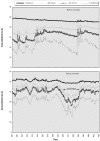Mold and endotoxin levels in the aftermath of Hurricane Katrina: a pilot project of homes in New Orleans undergoing renovation
- PMID: 17185280
- PMCID: PMC1764149
- DOI: 10.1289/ehp.9258
Mold and endotoxin levels in the aftermath of Hurricane Katrina: a pilot project of homes in New Orleans undergoing renovation
Abstract
Background: After Hurricane Katrina, many New Orleans homes remained flooded for weeks, promoting heavy microbial growth.
Objectives: A small demonstration project was conducted November 2005-January 2006 aiming to recommend safe remediation techniques and safe levels of worker protection, and to characterize airborne mold and endotoxin throughout cleanup.
Methods: Three houses with floodwater lines between 0.3 and 2 m underwent intervention, including disposal of damaged furnishings and drywall, cleaning surfaces, drying remaining structure, and treatment with a biostatic agent. We measured indoor and outdoor bioaerosols before, during, and after intervention. Samples were analyzed for fungi [culture, spore analysis, polymerase chain reaction (PCR)] and endotoxin. In one house, realtime particle counts were also assessed, and respirator-efficiency testing was performed to establish workplace protection factors (WPF).
Results: At baseline, culturable mold ranged from 22,000 to 515,000 colony-forming units/m3, spore counts ranged from 82,000 to 630,000 spores/m3, and endotoxin ranged from 17 to 139 endotoxin units/m3. Culture, spore analysis, and PCR indicated that Penicillium, Aspergillus, and Paecilomyces predominated. After intervention, levels of mold and endotoxin were generally lower (sometimes, orders of magnitude). The average WPF against fungal spores for elastomeric respirators was higher than for the N95 respirators.
Conclusions: During baseline and intervention, mold and endotoxin levels were similar to those found in agricultural environments. We strongly recommend that those entering, cleaning, and repairing flood-damaged homes wear respirators at least as protective as elastomeric respirators. Recommendations based on this demonstration will benefit those involved in the current cleanup activities and will inform efforts to respond to future disasters.
Figures





Similar articles
-
Characterization of airborne molds, endotoxins, and glucans in homes in New Orleans after Hurricanes Katrina and Rita.Appl Environ Microbiol. 2007 Mar;73(5):1630-4. doi: 10.1128/AEM.01973-06. Epub 2007 Jan 5. Appl Environ Microbiol. 2007. PMID: 17209066 Free PMC article.
-
Airborne mold and endotoxin concentrations in New Orleans, Louisiana, after flooding, October through November 2005.Environ Health Perspect. 2006 Sep;114(9):1381-6. doi: 10.1289/ehp.9198. Environ Health Perspect. 2006. PMID: 16966092 Free PMC article.
-
Resident cleanup activities, characteristics of flood-damaged homes and airborne microbial concentrations in New Orleans, Louisiana, October 2005.Environ Res. 2008 Mar;106(3):401-9. doi: 10.1016/j.envres.2007.11.004. Epub 2008 Jan 15. Environ Res. 2008. PMID: 18199434
-
Can we use indoor fungi as bioindicators of indoor air quality? Historical perspectives and open questions.Sci Total Environ. 2010 Sep 15;408(20):4285-95. doi: 10.1016/j.scitotenv.2010.07.005. Epub 2010 Jul 23. Sci Total Environ. 2010. PMID: 20655574 Review.
-
Does evidence support measuring spore counts to identify dampness or mold in buildings? A literature review.J Expo Sci Environ Epidemiol. 2022 Mar;32(2):177-187. doi: 10.1038/s41370-021-00377-7. Epub 2021 Sep 2. J Expo Sci Environ Epidemiol. 2022. PMID: 34475494 Review.
Cited by
-
Respiratory health effects associated with restoration work in post-Hurricane Katrina New Orleans.J Environ Public Health. 2012;2012:462478. doi: 10.1155/2012/462478. Epub 2012 Dec 9. J Environ Public Health. 2012. PMID: 23365586 Free PMC article.
-
Lessons from Hurricane Sandy: a community response in Brooklyn, New York.J Urban Health. 2013 Oct;90(5):799-809. doi: 10.1007/s11524-013-9832-9. J Urban Health. 2013. PMID: 24022182 Free PMC article.
-
Neuro-ophthalmic manifestations of fungal disease associated with posthurricane environment.J Neuroophthalmol. 2012 Sep;32(3):197-201. doi: 10.1097/WNO.0b013e3182268746. J Neuroophthalmol. 2012. PMID: 21799448 Free PMC article.
-
Household endotoxin reduction in the Louisa Environmental Intervention Project for rural childhood asthma.Indoor Air. 2020 Jan;30(1):88-97. doi: 10.1111/ina.12610. Epub 2019 Nov 22. Indoor Air. 2020. PMID: 31605641 Free PMC article.
-
Hurricane-Associated Mold Exposures Among Patients at Risk for Invasive Mold Infections After Hurricane Harvey - Houston, Texas, 2017.MMWR Morb Mortal Wkly Rep. 2019 May 31;68(21):469-473. doi: 10.15585/mmwr.mm6821a1. MMWR Morb Mortal Wkly Rep. 2019. PMID: 31145717 Free PMC article.
References
-
- Adhikari A, Martuzevicius D, Reponen T, Grinshpun SA, Cho S-H, Sivasubramani SK, et al. Performance of the button personal inhalable sampler for the measurement of outdoor aeroallergens. Atmos Environ. 2003;34:4723–4733.
-
- American Red Cross and Federal Emergency Management Agency 1992. Repairing Your Flooded Home. ARC 4476, FEMA L-198. Jessup, MD:American Red Cross and Federal Emergency Management Agency. Available: http://www.redcross.org/static/file_cont333_lang0_150.pdf [accessed 16 October 2006].
-
- Balazy A, Toivola M, Reponen T, Podgorski A, Zimmer A, Grinshpun SA. Manikin-based performance evaluation of N95 filtering-facepiece respirators challenged with nanoparticles. Ann Occup Hyg. 2006;50:259–269. - PubMed
-
- CDC 2005. Mold: Prevention Strategies and Possible Health Effects in the Aftermath of Hurricanes Katrina and Rita. Atlanta, GA:Centers for Disease Control and Prevention.
-
- Chen P, Eggleston PA. Allergenic proteins are fragmented in low concentrations of sodium hypochlorite. Clin Exp Allergy. 2001;31:1086–1093. - PubMed
Publication types
MeSH terms
Substances
Grants and funding
LinkOut - more resources
Full Text Sources
Medical

